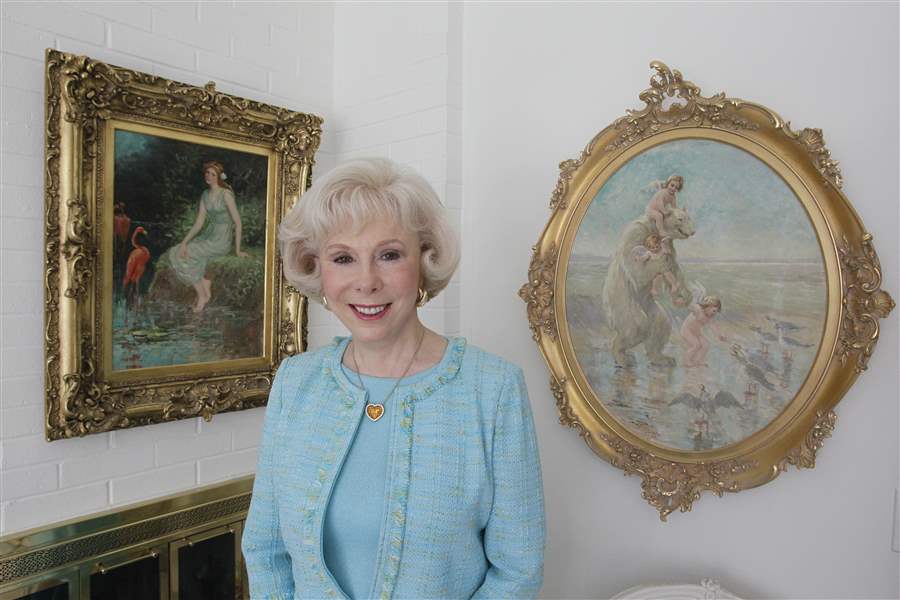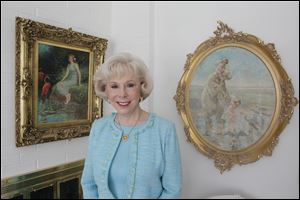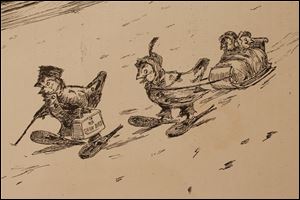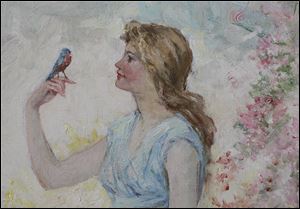
Local woman collects what she loves: graceful works by painter F.S. Church
6/12/2011
Jill Koehler of Toledo poses with two of Church's paintings, his 1911 "Flamingoes," left, and 1899 "The Morning Bath."
The Blade/Jetta Fraser
Buy This Image

Jill Koehler of Toledo poses with two of Church's paintings, his 1911 "Flamingoes," left, and 1899 "The Morning Bath."
Jill Koehler learned from her mother that it was important to own tangible assets that maintain their value. Put into practice: As a child growing up in Findlay, Jill, who ached for a pony, received a few shares of stock for her birthday and at Christmas.
"Mother believed that loving nice things would make us work hard to earn them. She thought that money was wasted in frivolous consumption and taught us to think of all our purchases as an investment," said Koehler, who lives in West Toledo.
Art, like gold, is one of those tangible assets.
So, during the first 10 years she worked as a stock broker, Koehler purchased drawings by French artist Louis Icart, paying between $1,500 and $12,000 for each. In 1987, when a dealer asked her to sell her 32-piece collection to a Japanese man, she agreed, delighted to triple her original investment. Mother was right.
Koehler then cast about for another artist in her price range to collect and an Ann Arbor dealer tried to interest her in several. But nothing compared to the enchantment she felt when she looked at The Nymph, a large oil painting in her sister’s living room of a wistful maiden in a diaphanous green gown, her left arm draped around the neck of a tiger. It was painted in 1904 by F. S. Church, who neither she nor the dealer had heard of. (Another artist of similar name, Frederic Edwin Church (1826-1900) was an American landscape painter.)
A few years later, the dealer presented her with three paintings by the forgotten Frederick Stuart Church.

"The Princess in the Fairy Tale," by F.S. Church, 1901.
"I said, ‘I love them all! That’s who I want to collect.’ "
Today, her collection of 29 paintings by Church (1842 to 1924) is thought to be the largest anywhere. Most are included in a glossy 2010 book, Frederick Stuart Church: A Brush with Imagination by Dale and Rose Marie Horst.
"Jill’s collection was a major factor in doing a book. It was a major source of paintings for us to write about," said Dale Horst from his home north of Wichita. "Her collection spans a great deal of his career."
Well-respected and prolific, Church did more than a thousand illustrations for the great magazines of the day such as Harper’s Weekly, Scribner’s, and children’s periodicals, along with art for advertising, greeting cards, and commissioned paintings. A clever letter-writer, his fun-loving personality and skill at maintaining friendships resulted in the avid support of several patrons, one of whom built Church a country studio at his New Jersey estate.
Charming and cheery, his work suggests stories whose protagonists are beautiful little girls or maidens and well-crafted animals, often graced with human characteristics. His white bears smiled, danced, sipped afternoon tea, and made Christmas pudding. Indeed, Koehler suspects Church transferred his persona to the bears.
In what could be straight out of a Disney playbook is his 1901 painting of a pink-gowned princess walking with a delicate ribbon around a fawn’s neck, her long train being carried by polite pairs of polar bears, fox, rabbits, and storks. In 1914, he painted a lass, clad in the same V-necked filmy dress his young women always wore, gazing at a blue bird lighting on her hand; it suggests the Blue Bird of Happiness.

Detail from "The Christmas Pudding," an engraving that originally appeared in Harper's Weekly, date unknown.
Koehler loves the sweetness of his characters.
"I think Church represents a different kind of life than what has evolved in the last 60 to 70 years in the United States. It was a kinder, gentler, more playful time. It was a simpler time."
A 1905 article about Church said, "The distinctly American character of the landscape settings of his paintings is the result of thorough familiarity with every phase of outdoor life."
And from a 1920 Scribner’s article: "A constant discussion was waged in men’s clubs and ladies’ drawing-rooms concerning the real meaning of Mr. Church’s pictures. Did he intend to show the power of feminine purity and its ability to subdue all passions, however savage? Or did the beautiful young girl who recurred so constantly throughout his work more comprehensively represent an all-embracing heavenly love? Were the paintings allegories, in short; and was Mr. Church in reality a great moral teacher?"
Born in Grand Rapids, Mich., Church was sent to Chicago at 13 to live with his mother’s sister, married to James Fargo, a partner in the young American Express Co. At 18, he left to fight for three years in the Civil War and upon return, worked at his uncle’s firm.
At 28, he moved to New York City, and at 30, his first illustration was published in Harper’s Weekly. He arrived in New York at the same time the new Central Park Menagerie opened and he visited so regularly, sketch pad in hand, he befriended the staff who let him enter after hours. They even manipulated the animals for him. The director placed a bear cub near a tiger so Church could see an enraged beast. He took a dog to the owls’ cage to observe the birds’ excitement. And when a gramophone was played to monkeys to test their responses, Church was there.
"He’s a part of our culture and history," said Horst. "A lot of his work has been described as the Peaceable Kingdom and he said a number of times that what he was showing was sentiment and the power of beauty over the beast."
The history and art-loving Horsts discovered Church by way of collecting engravings of editorial cartoons by Thomas Nast, considered the father of the American cartoon, from the late 19th century. Artists’ work could not be directly reproduced at the time. The technology required skilled engravers to carve images from an illustration or painting onto wood blocks, which would then be used in the printing process.

Detail of "The Blue Bird," 1914.
About 22 years ago at a flea market not far from their home, they noticed two engravings by Church, who they’d never heard of. One, from a Harper’s Weekly magazine dated Dec. 12, 1885, portrays a winsome lass in a holiday dress dancing merrily down the road; she’s got a white bear on each arm and they’re followed by a bunch of music-making bears. The group heads toward a bear in an apron and chef’s cap holding a big Christmas pudding.
They took their illustrations home and hung them. "As we walked by them, they made us smile and feel nice," said Horst. "That began our search to find more of them."
For years, they spent weekends reviewing three decades’ worth of Harper’s Weekly, page by page on microfilm at Wichita State University, thrilled when they found illustrations by Church between 1872 and the 1890s. They sought out dealers who specialized in old newspapers and they now own more than 1,000 Church illustrations. It was through a dealer that they met Koehler.
When Horst retired from doing psychopharmaceutical research, he began writing the book, a four-year process.
He learned Church had never married and was bedevilled by drink, bouts with depression, joint pain, and cataracts, all of which worsened as he aged. He didn’t cotton to new trends in art such as European Impressionism and cubism. "He refused to change. He liked what he did and continued to do that," said Horst.
And as aesthetics changed, his work became passé.
"Well before he died, Church’s artistic career succumbed to technology and aesthetic changes," the Horsts wrote in the book. "The art editors who favored his illustrations were long gone; the organizers of art exhibits had long rejected beauty and sentiment; his professional community completely replaced long ago."
Koehler’s advice when collecting art as an investment is to love the work: that will soften the disappointment if it doesn’t increase in value. Her Church paintings have doubled in value. And she now owns The Nymph, the painting she first fell in love with. She bought it from her sister, who doubled her money when she sold it to Koehler.
Contact Tahree Lane at:
419-724-6075 or
tlane@theblade.com